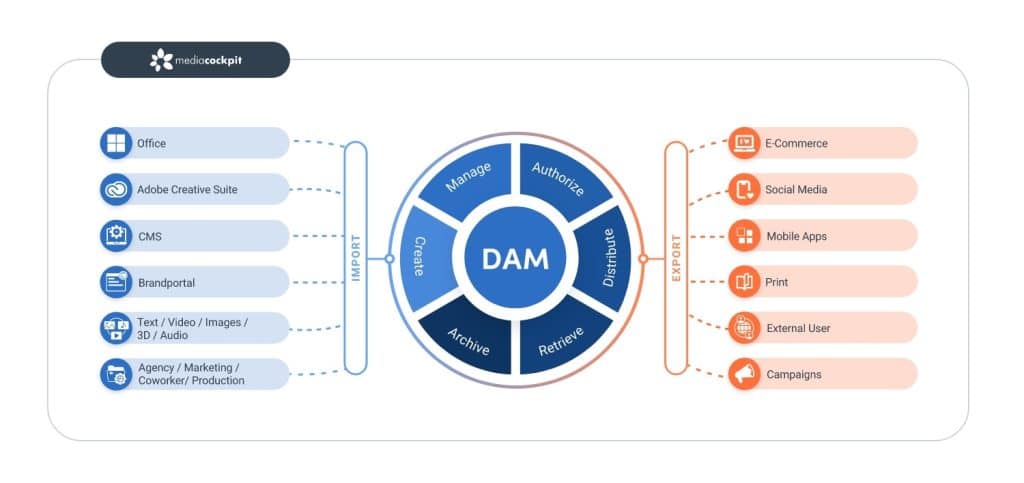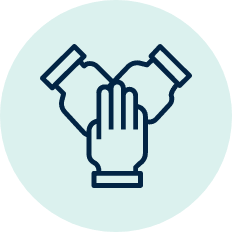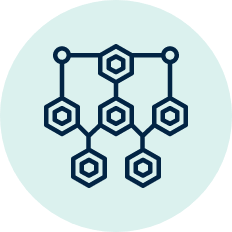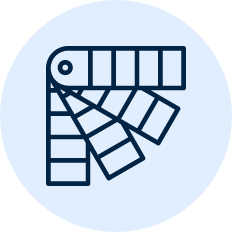Everything you need to know about DAM
What is Digital Asset Management (DAM)?
Images, videos, audio- and graphic files – a Digital Asset Management system manages all media files centrally from a single source

What is the importance of digital asset management for a company?
Most organizations have a variety of digital assets such as images, videos, audio files, presentations, logos, graphics or PDFs. In many cases, these media files are stored in different locations within the organization, different versions or duplicates often exist, and access to these assets is also often limited for many employees. A Digital Asset Management software, on the other hand, provides a central location for creative content and neatly and reliably manages different versions as well as access rights and user roles. Due to the growing importance of multimedia assets, mediacockpit has its own integrated DAM component that supplements product information in the PIM (Product Information Management) with the corresponding complementary functions.
Companies whose product communication depend on the support of image and video material can no longer afford to work without a powerful DAM software. For example, large fashion retailers advertise each piece of clothing with multiple images for each color and from different perspectives, as well as including short videos for specific products. When these retailers add new collections to their offerings, all of this data must be available quickly. The same applies to high-priced electronics, for example, where small advertising videos or even data sheets often complete the product description.
Thanks to managing access rights, DAM systems also provide an excellent basis for collaboration between different departments, but also with external users such as agencies or freelancers. Everyone involved in content creation can be sure that the media data provided is correct and up-to-date. In addition, intelligent workflows and clearly defined responsibilities ensure transparent and reliable processes, from image editing to distributing to the various marketing and sales channels.
Key capabilities of a DAM software
Digital asset management solutions manage media such as images, videos, audio or graphics files in different file formats and versions. This makes it possible to track changes, for example. Product images can be stored in different sections, dimensions, and formats, and can be routed out appropriately for each distribution channel. Since many different internal and external users often work with digital assets, DAM solutions also have sophisticated rights management that enables efficient workflows with maximum security and transparency.
Numerous interfaces intelligently integrate the central DAM with the existing IT landscape. For example, mediacockpit has interfaces to content management systems (CMS), online stores, creative tools such as plugins for Adobe InDesign and Adobe Photoshop, and Microsoft Office Applications. In this way, the DAM system becomes a central hub for all digital assets in the company – no matter where they are created, edited, or ultimately published.

What data is managed in a DAM software?
In a DAM system, unstructured data is managed, maintained, enriched, and made available. Unstructured data refers to information elements that do not exist in a formalized structure. Unlike structured data, which is set up under a defined data model, unstructured data is not interpretable itself to begin with – it is like a vessel that cannot be easily looked into. This includes:

Images

Videos

Audio files

Presentation such as PPT files

PDFs

Logos

Banners

Text files
What data is not managed in a DAM solution?
Structured data such as product information, customer data, or master data is not managed in a DAM solution. This type of information requires special data models that are mapped by product information systems (PIM), customer relationship management systems (CRM) and enterprise resource planning systems (ERP).
What other terms are there for Digital Asset Management?
Precisely because of the large number of different assets, there are some terms that are used synonymously with DAM. These include video asset management, if only video data can be managed, brand asset management, media management, (rich) media asset management, digital content management or digital media management.
When does a DAM solution make sense for you?
DAM software makes sense when a company creates and holds a variety of media such as images, videos, audio files, presentations, graphics or PDFs and wants to manage them as efficiently as possible – especially considering cross-location collaboration, internationalization, and working with external parties such as agencies, the press, or photographers.
What are the technical requirements for a DAM implementation?
There are now various ways of introducing software into companies. Whether a software-as-a-service (SaaS) model, a hybrid solution, or an on-premise installation is favored, depends on various factors. For example, the overall architecture with the surrounding systems plays a major role, but the company’s long-term strategy also influences the choice of the appropriate option. Therefore, mediacockpit offers the right model for every need.
However, most companies today turn to browser-based SaaS solutions, where complex maintenance work and updates are carried out by the provider and companies are very flexible in the use and utilization of the software. Since the framework conditions for data use can change very dynamically in the modern corporate world, the flexible use of a SaaS solution has become established. Nevertheless, there are companies that prefer to store their data on their own servers and databases, which is why these alternatives are often offered in parallel.
What other aspects play a role introducing a DAM software?
The technical requirements for a DAM implementation are hardly a headache anymore. It is more important for companies to consider exactly which digital assets they have or will have in the future, what the procurement and provision processes look like, and which users are involved in the digital value creation process. Only when this basic structure has been clearly outlined, a DAM implementation should be carried out without having to make major adjustments afterwards.
What are the benefits of Digital Asset Management?
Thanks to central data storage, clearly defined processes and intelligent workflows, DAM solutions offer many advantages – and not just for international companies that own large quantities of creative content and have to cater to a large number of distribution channels.


DAM software saves time and money
Without a central data repository, product and corporate images, documents and presentations have to be painstakingly sourced by hand – assuming that it is known where these assets are located within the company. Very often, such media is created once for a specific purpose, stored somewhere locally, and then forgotten about. With a DAM solution, all digital assets are made available centrally, enabling multi-use of image, video, audio, and graphic files. This can save a lot of time and internal effort, especially in international companies that use many different output channels such as websites, apps, marketplaces or social media. But costs can also be saved in the sourcing and creation of digital assets thanks to reusability, for example for multinational campaigns.
Customer Experience Management: when DAM and PIM join forces
While PIM systems provide all relevant channels with up-to-date and complete product information, DAM systems deliver the digital assets as complementary solutions. As an integrated marketing platform, mediacockpit therefore offers both a PIM and a DAM component. In this way, products can be presented in a multifaceted and comprehensive way on all user interfaces. While consumers can touch products in physical stores, examine them from all angles, and compare them optimally with each other, they rely on all this visual information online. The more of it is made available, the better users can experience the products – even digitally. Some fashion stores have recognized the importance of visual product presentation and, in addition to numerous photos, also publish small videos of their items that illustrate how the fabrics fall in motion.


DAM solutions facilitate collaboration
Clear management of user roles and rights not only enables clean cross-departmental collaboration within a company. It also makes collaboration with external parties such as agencies, photographers or freelancers much easier. In addition, rights management creates security and ensures compliance when dealing with sensitive digital assets.
DAM prevents data chaos and dead ends
Forgotten presentations, hidden graphics, or product images filed twice and three times: A central DAM makes all creative content in the company visible and easily accessible. This reduces the search for suitable image material, for example, to a few clicks, and the mess of different file versions and non-transparent changes are now history.
Which users profit most from a DAM software?
Basically, everyone involved in the creation and usage of digital assets in the organization benefits from a digital asset management solution like mediacockpit. This includes in particular:


Product managers
Product managers are responsible for ensuring that products are mapped according to the requirements of the output channels. This includes product information, which is managed in a PIM software, but also media data such as product images or data sheets. A DAM solution facilitates the management of creative content enormously.
Marketing, social media managers, webmasters
Marketing managers need a wide variety of material for their communication activities. This includes product data but also creative content like images, videos, and PDFs. Requesting this material from different places and departments is no longer an option, especially in the digital world. Creative content must be immediately available with intelligent search and filter options – and suitable for every relevant interface.


Graphic design
Since graphic design is directly involved in the creation of digital assets, this audience benefits from the excellent collaboration possibilities offered by a DAM software. Trackable changes, commenting features, and transparent versions help keep track of what’s happening at any given time and enable graphic design teams to effectively collaborate on logos and other creative content.
External
Not only employees within the organization benefit from a DAM solution – third parties such as agencies, photographers, freelancers, or the press can also collaborate directly with employees with access to digital assets and the functions of the DAM software tailored to their role. This optimizes cross-company workflows and processes and increases the satisfaction of everyone involved.


